Tandoor bread
Tandoor bread refers to a bread baked in a clay oven called a tandoor.[1]
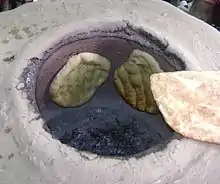 Tandoor flatbread in Azerbaijan | |
| Place of origin | Mesopotamia, Indus Valley |
|---|---|
| Main ingredients | Flour |
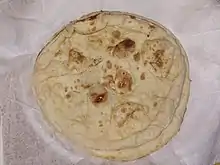
History
Cooking food in a tandoor oven has been done for about five millennia. Remains of a clay oven with indication of cooked food have been excavated in the Indus River valley site of Kalibangan,[2] and other places in present-day Afghanistan, Pakistan, northwest India, Iran, Iraq and Central Asia.[3]
The English word tandoor comes from Hindi/Urdu tandūr (तन्दूर / تندور), which derives from Persian tanūr (تنور) or tandūr (تندور). According to the Dehkhoda Persian Dictionary, the Persian word ultimately came from the Akkadian word tinūru (𒋾𒂟), which consists of the parts tin 'mud' and nuro/nura 'fire' and is mentioned as early as in the Akkadian Epic of Gilgamesh. Tandoor has been referred to as kandu in Sanskrit literature, in which tandoori parched, roasted cuisine is described as kandu pakva (roasted in a tandoor such as grains, meat, etc.) along with roasting on coal which has been called angara pakva.[4]
Tandoor ovens are not prevalent in the average Indian home because they are expensive to fabricate, install and maintain.[5] Authentic tandoori cuisine in urban areas can often be found in specialty restaurants.[3] However, in rural areas in India such as Punjab, the tandoor oven is considered a social institution, for a tandoor oven is shared among the community. Women would go to the oven place with atta along with their marinated meats to meet their neighbors and friends, so they could converse and share stories while waiting for their food to cook.[6] The people in cities once engaged in this social activity, but as businesses and commercialism grew in these areas, communal tandoor ovens have become rare. Not uncommonly, people bring food to their local bakeries to cook it there at a fair price.[3]
Because of the growing inaccessibility of a tandoor oven in urban areas, especially in cities outside of Southern Asia, people have developed ingenious techniques to replicate the cooking process and the food without the use of the oven. Common alternatives include an oven or a grill fueled by charcoal or wood so the food will be infused with the smoky flavor.[3]
Varieties
West Asia

The Arabic name for tandoor bread is ḵubz al-tannūr ('bread of the tannur' Arabic: خبز التنور). In some places where it is especially common, such as Iraq, it may be called simply khubz (bread).[7] It is similar to, or in some cases the same as, taboon bread.
In Iran, tandoor breads are known as nân-e-tanūri (Persian: نان تنوری). Varieties include nân-e barbari (Persian: نان بربری), tâftun (تافتون), and shirmal (شیرمال).
In Georgia and Armenia, a traditional tandoor is called a tone (Georgian: თონე) and tʿonir (Armenian: թոնիր), and the bread baked in the tone are called tonis ṗuri (Georgian: თონის პური or tʿonir hacʿ Armenian: թոնիր հաց). Canoe-shaped shoti (Georgian: შოთი) is a kind of tonis ṗuri. Lavash (Armenian: լավաշ lavaš, Georgian: ლავაში lavaši) is an unleavened variety of tandoor bread eaten in this region.
Central Asia
In Central Asia, tandyr nan (Kazakh/Kyrgyz: тандыр-нан tandır-nan, Uzbek: tandir non, Uyghur: تونۇر نان tonur nan, Tajik: нони танурй noni tanuri) is made and eaten.
In Turkey and Azerbaijan, breads baked in tandoor are called təndir çörəyi (Azerbaijani) and tandır ekmeği (Turkish).
India
Tandoor breads are popular in northwestern Indian regions, especially in Himachal Pradesh, Gujarat, Jammu and Kashmir, Uttar Pradesh, Bihar, Madhya Pradesh, Uttarakhand, Rajasthan, Haryana and Punjab regions, where naan breads and atta flat breads such as the Tandoori roti are baked in tandoor clay ovens fired by wood or charcoal. These naans are known as tandoori naan (Gujarati: તંદૂરી નાન, Hindi: तंदूरी नान).[8] Tandoor ovens are not prevalent in the average Indian home because they are expensive to fabricate, install and maintain.[5] Authentic tandoori cuisine in urban areas can often be found in specialty restaurants and dhabas, which are street-side reasonably fared restaurants that usually line Indian highways.[3] However, in rural areas in India such as Punjab, the tandoor oven is considered a social institution, for a tandoor oven is shared among the community. Women would go to the oven place with atta along with their marinated meats to meet their neighbors and friends so they could converse and share stories while waiting for their food to cook.[6] The people in cities once engaged in this social activity, but as businesses and commercialism grew in these areas, communal tandoor ovens have become rare. Not uncommonly, people bring food to their local bakeries to cook it there at a fair price.[3]
Pakistan
In Pakistan, tandoor breads are a staple across the country. In rural areas, each home often has its own tandoor, while in urban areas commercial tandoors are available where people buy bread for breakfast, lunch, and dinner. These commercial tandoors are especially popular during summer times when high temperatures in parts of the country make cooking bread at home an unpleasant chore.
These breads range from a simple Tandoori roti which is unleavened bread, to yeast-based khamiri roti, as well as richer and more complex (yeast, milk, egg, etc.-based) naans and kulcha breads.[8] In Pakistani cuisine, specific types of tandoori breads are often eaten with specific foods. Some of the most popular tandoori breads include Sheermal, Taftan, and Roghni naan.
Commonly, central tandoor was often a social institution where people would bring their atta or dough to be cooked; and bartered with the baker using gandum (Urdu: گندم) or wheat. In addition to savory breads, tandoors in Pakistan are also used to bake various sweet and semi-sweet breads such as sheermal (شیر مال) and qand kulcha (Urdu: قند کلچہ).
Because of the growing inaccessibility of a tandoor oven in urban areas, especially in cities outside of Southern Asia, people have developed ingenious techniques to replicate the cooking process and the food without the use of the oven. Common alternatives include an oven or a grill fueled by charcoal or wood so the food will be infused with the smoky flavor.[3]
Tandoori roti is commonly consumed in South Asian countries such as Pakistan and India.[9] This bread is served in restaurants, hotels, industrial canteens and at home. It is also gaining popularity in Asia, North America (outside of the Caribbean) and Europe due to migrants during British colonialism.[10]
Caribbean
Tandoor bread is found in Caribbean countries such as Guyana, Suriname and Trinidad and Tobago (as roti).[11]
Physical and chemical composition
Aroma, smell, appearance, color, size and overall texture are the general characteristics that are optimized by producers of tandoor bread.[10] The texture and quality of tandoor bread are determined by the percentage of wheat protein, the number of essential amino acids and type of flour present in the bread.[12][13] Various studies have demonstrated that the chemical and biochemical composition of flours affects the flour's ability to interact with the other ingredients in tandoor bread.[10][12]
Response surface methodology is a process which allows for development of palatable tandoor breads that have a long shelf life and contain minimal amounts of polycyclic aromatic hydrocarbons, which may pose health hazards.[14] For optimal sensory and chemical stability of tandoor bread, the water level is 720 milliliters per kilogram, protein concentrations range from 10.3% to 11.5%, between 1.2 and 1.6% salt is added, and the bread is baked in temperatures ranging from 330 to 450 °C.[9]
Gallery
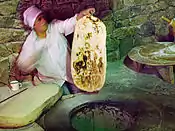
 Baking tandoor bread in Azerbaijan
Baking tandoor bread in Azerbaijan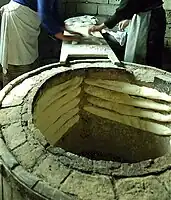
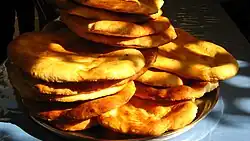 Prepared tandoor bread
Prepared tandoor bread Making tandoor bread in India
Making tandoor bread in India
References
- http://kabobcentral.com/tandoorbpage.html
- "Tandır Ekmeği". Malatya Haber (in Turkish). Archived from the original on 2008-12-21. Retrieved 2011-01-06. - Sanghvi, Vir (2004). Rude Food: The Collected Food Writings of Vir Sanghvi. Penguin Books India. ISBN 9780143031390.
- Lawler, Andrew (2013-01-30). "The Mystery of Curry". Slate.
- Ritu, Grishm. "Virasat" (PDF).
- Bhuyan, Avantika (2017-04-09). "How archaeologists across the country are unearthing the food of ancestors to shed light on the evolution of eating". The Economic Times. - Chandra, Smita (1999). Indian Grill: The Art of Tandoori Cooking. Manhattan: The Ecco Press. ISBN 978-0880016872.
- Monier-Williams, Monier (1872). A Sanskrit-English Dictionary: ...with Special Reference to Greek, Latin, Gothic, German, Anglo-saxon... Clarendon. p. 201.
kandu pakva.
- Jaffrey, Madhur (2011). An Invitation to Indian Cooking. New York City: Knopf. ISBN 978-0375712111.
- Malhi, Manju (2005). India with Passion: Modern Regional Home Food. Northampton: Interlink Pub Group Inc. ISBN 978-1566566094.
- Doug Smith (1 December 2007). "Iraqi bakeries make dough while they can". Los Angeles Times. Retrieved 15 March 2011.
- Cavendish, Marshall (2007). Peoples of Western Asia. Marshall Cavendish Corporation. p. 336. ISBN 978-0761476771.
- Gocmen, D.; Inkaya, A.N.; Aydin, E. (2009). "Flat Breads" (PDF). Bulgarian Journal of Agricultural Science. 15: 298–306.
- Saxena, Dharmesh C.; Salimath, Paramahans V.; Rao, Punaroor Haridas (2000). "Indian wheat cultivars: their carbohydrate profile and its relation to tandoori roti quality". Food Chemistry. 68 (2): 185–190. doi:10.1016/S0308-8146(99)00174-0.
- "Food in true Trini style". Barbados Today. 2 September 2017. Archived from the original on 22 July 2019. Retrieved 22 July 2019.
- Galali, Yaseen (2014). Quality and Shelf-life of Pita and Tandoor Breads Supplemented with Three Novel Functional Ingredients (Thesis). Plymouth University – via Pearl.
- Hasmi, Irfan A. (1996). Wheat and flour properties affecting tandoori bread quality. vuir.vu.edu.au (phd). Werribee, Australia: Victoria University of Technology. Retrieved 2018-03-06.
- Chawda, Shruti; Tarafdar, Abhrajyoti; Sinha, Alok; Mishra, Brijesh Kumar (2017). "Profiling and Health Risk Assessment of PAHs Content in Tandoori and Tawa Bread from India". Polycyclic Aromatic Compounds. 40: 21–32. doi:10.1080/10406638.2017.1349679. S2CID 102741102.

